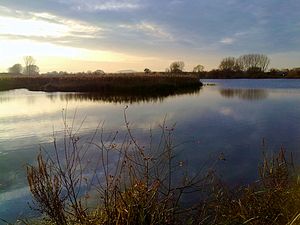Reinheimer pond
|
Reinheimer pond
|
||
| location | Darmstadt-Dieburg district , Hesse | |
| surface | 75 ha | |
| WDPA ID | 82390 | |
| Natura 2000 ID | DE6019303 | |
| Geographical location | 49 ° 51 ' N , 8 ° 51' E | |
|
|
||
| Sea level | from 150 m to 153 m | |
| Setup date | December 19, 1975 | |
The Reinheimer Teich is a nature reserve northeast of Reinheim in the Darmstadt-Dieburg district . It consists of some open water areas, reeds, wet meadows and extensive pasture areas with a total area of about 75 ha. It is a nationally important habitat for the European pond turtle and breeding and resting place for numerous species of birds.
history
In the past, today's nature reserve was a wetland and was called "Reinheimer Bruch". After it was sold to Landgrave Ludwig V by the communities of Reinheim and Spachbrücken in 1625, pond master Barthold Mayer created several fish ponds for carp and pike from 1626 under Landgrave Georg II . For this purpose, a dam was built and the Wembach and water from the Gersprenz were introduced. Until the middle of the 19th century, the area was used alternately for fishing and as grassland. From 1910 it belonged again to the community of Reinheim and served as pasture and mowing grassland.
On December 19, 1975, the Reinheimer Teich nature reserve was designated. In 1976/77, damming and dredging created open water areas with deep and shallow water zones. Today the nature reserve also forms the central component of the larger Natura 2000 areas "FFH area Untere Gersprenz" (772.9 ha) and "Bird sanctuary Untere Gersprenzaue" (3232 ha).
Location and geology
The area is located in the Reinheim basin in the northwestern foreland of the Odenwald at an altitude of about 150 meters and is almost flat. The subsoil is formed by river deposits from the Gersprenz and its tributaries, in the western part clay-covered gravel from the Young Pleistocene , but mostly several meters thick, sandy-silty sediments from the Holocene . The wetland is largely surrounded by dams and drains northwards through several ditches to the Gersprenz.
animals and plants
The nature reserve is the habitat for 101 bird species, 64 of which are breeding bird species, for example white storks , a colony of gray herons , the marsh harrier and numerous water and meadow birds . Many migratory birds use the area as a resting place or for wintering, including the great egret , bittern and hen harrier . In addition, 12 fish species, four bat species, six amphibian species (including the tree frog ), 28 butterfly species, 16 grasshopper species, 21 dragonfly species, 89 ground beetle species and 120 spider species were detected. These include many threatened and rare species that are on the Red Lists of Hesse or Germany. The beaver is also at home here again.
The occurrence of the European pond turtle , which has one of its last autochthonous occurrences in Hesse, is particularly important . The University of Frankfurt investigated their hiking trails, egg-laying places, sun spots and behavior, partly with the help of transmitters.
Broad-leaved orchid , blackhead sedge , strawberry clover and swamp violet grow on the banks and in the meadows . A total of 12 endangered plant species were identified.
Information for visitors
There is a three-kilometer circular path around the nature reserve. Several boards provide information about the history, fauna and flora and life in the water.
The visitors can get more information in the nature reserve Reinheimer Teich, in the west outside the nature reserve. It was founded in 2005 under the sponsorship of NABU and HGON and built up from a former agricultural hall as a volunteer. The ongoing operation is also carried out by volunteers. The nature reserve barn is open on Sundays and public holidays in the summer months and offers changing exhibitions, guided tours, lectures and workshops. In the naturally redesigned outdoor area, the various biotopes of the Reinheimer pond can be explored up close at any time.
A newly hatched pond terrapin was discovered for the first time in 2014 at the nature reserve barn.
Individual evidence
- ^ A b c d Uta Hillesheim-Kimmel, Helmut Karafiat, Klaus Lewejohann, Wolfram Lobin: The nature reserves in Hessen. Institute for Nature Conservation Darmstadt, Series XI, 3, 2nd edition, 1978, pp. 56–58.
- ↑ Teichgräber Barthold Mayer, 1597-1672. Source: Hessian Family History Association, Karolinenplatz 3, 64289 Darmstadt.
- ↑ a b c d e f The Reinheimer pond . Website of the city of Reinheim, last accessed on January 29, 2017.
- ↑ FFH area 6019-303 Untere Gersprenz , Natura 2000 - ordinance of the Darmstadt Regional Council.
- ↑ Bird sanctuary 6119-401 Untere Gersprenzaue . Natura 2000 - ordinance of the Darmstadt Regional Council.
- ↑ Naturschutzscheune Reinheimer Teich , website, last accessed on January 29, 2017.
- ↑ European pond turtle found at Reinheimer Teich , press report in Echo online from April 21, 2014.
literature
- Heinz Reitz: The Reinheimer pond and its history. In: The Odenwald. Zeitschrift des Breuberg-Bundes 30/1, 1983, pp. 3-15.
Web links
- Norbert Kühnberger: NSG Reinheimer Teich (bird watching since 1997)





